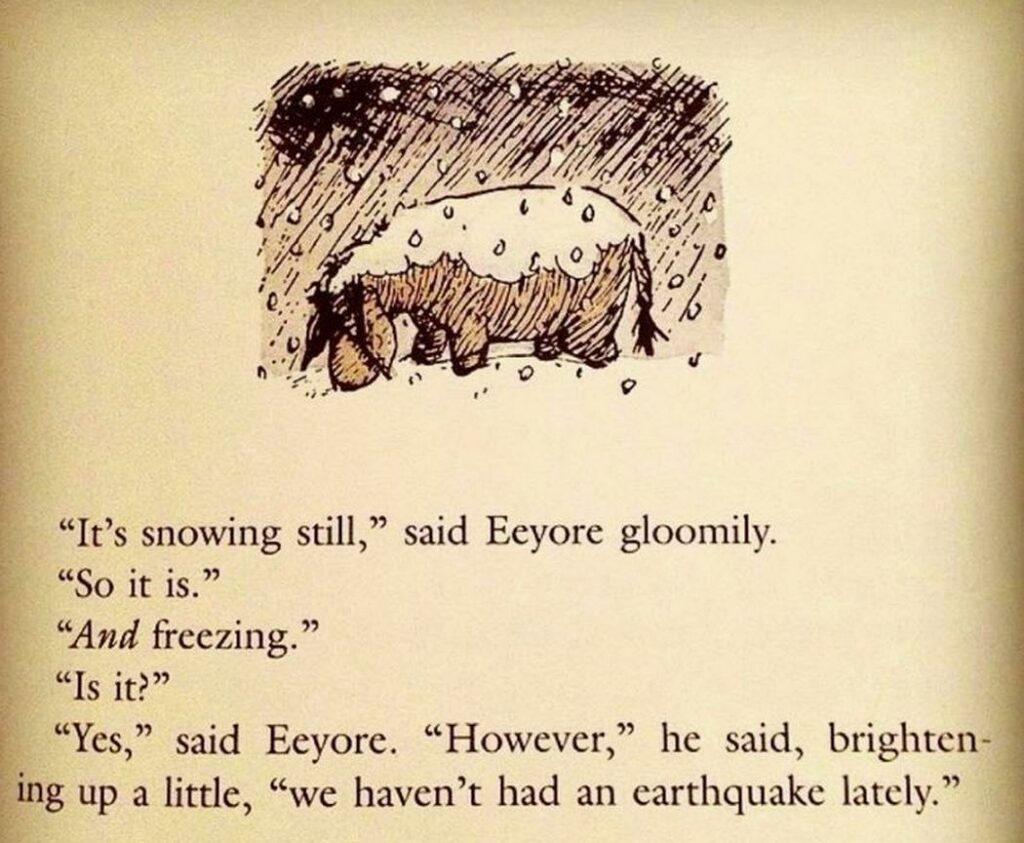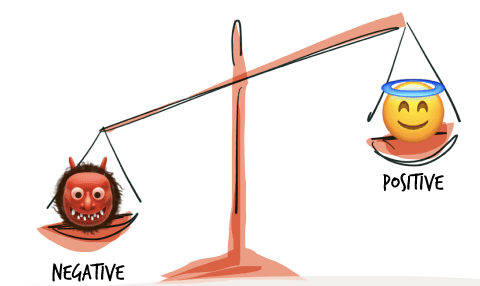“It was the best thing that ever happened to me!”
How often have you looked back at a so-called ‘bad’ event and realised that it was actually a blessing in disguise? This of course, is the benefit of hindsight. The ability to look back on a situation and see the silver lining it brought you. Which makes me wonder: how good are we at really reading, seeing and understanding the impact of a situation right there in the moment? Due to the brain’s negative bias and the fight or flight response, we go into short term thinking patterns when ‘bad’ things happen. We are often unable to see the ‘bigger picture’ so to speak. It’s not until later down the line when we are able to ‘join the dots’ as Steve Jobs said and see the benefits of some challenging situations. Now imagine what your life would be like if you could always have an eye on that silver lining, even from the middle of a storm? Tapping into the wisdom of hindsight, amidst the grey clouds of a difficult and stressful life event.

In this article we’re looking at ways of finding the silver lining during difficult situations. This isn’t about excessive optimism, it’s about widening your lens, seeing the multiple and contradictory truths of a situation and stepping into other people’s shoes. The ability to see silver linings has huge health benefits as it can greatly reduce stress, insomnia and depression whilst also positively impacting learning, relationships and present awareness. So, join us as we look for life’s silver linings in some of the darkest corners of our lives. To quote the Taoist Parable about the farmer and his horse “who knows what’s good or what’s bad?” Good and bad is a false dichotomy. This is why the ying yang symbol shows a white dot on the black side and a black dot in the white side. We see black and white, right or wrong as binary and contradictory when they are in fact, complimentary and fluid. So today, we’re looking for the grey space in between good and bad. The silver lining that blends these two stances together and softens the extremes.
Reframe the situation
“It was the best of times it was the worst of times”
– Charles Dickens
Cognitive reappraisal involves recognising negative thought patterns and changing them to patterns that are more helpful. One study titled “Seeing the Silver Lining: Cognitive Reappraisal Ability Moderates the Relationship Between Stress and Depressive Symptoms” found that Cognitive reappraisal – or CRA for short- was an important protective factor against long-term depression in response to stressful life events. “Individuals who are high in CRA could perceive a stressor as an extremely negative event in terms of disrupting their lives, but could still decrease their negative emotions in response to this event.” So, what is the process of CRA? Responding to an emotional situation will result in an automatic judgement of the situation (the appraisal). Cognitive re-evaluation, involves looking at the situation again and offering a second opinion (the reappraisal). The reappraisal is more neutral and objective, because there is space between the emotional event and the verdict. So, the ‘reappraisal’ can offer us a sense of the ‘benefit of hindsight’ but in real time. Which is why training yourself to do this can be highly effective when emotions are running high- as it enables you to access a second opinion inside yourself.
I recently experienced the benefits of cognitive reappraisal in response to a house flood. My initial reaction was stress and worry (perhaps rightly so) as the rather dramatic event has created so many issues, cost a small fortune and wasted so much of my time, filing insurance claims and looking for temporary accommodation. Whilst all of that is true…we’ve now found somewhere else to live for the summer… and we’ve decided to treat it as a ‘holiday home.’ The basement was also the only part of the house that didn’t need redecorating- so now we have an excuse to spruce up that room too! Most importantly, my ‘reappraisal’ of the event offered me an important lesson in what’s important life. Not long after I heard the news, I found myself feeling incredibly grateful: no one was hurt, we have- another- roof over our heads, and I felt lucky to have such a supportive network of friends and family living nearby.

Heighten awareness
“Time was invented so that misery might have an end.”
– Saul Bellow
Are we really seeing what is happening in front of us? Or are we locked in the emotions of a past event and missing positives of the present moment? Dr. Joe Dispenza says: “For most people, living in the safety and comfort of the known past is a lot safer than stepping out into the unknown future. Living in the past also validates all of the traumas and betrayals we’ve had in our life, not to mention it makes for a great excuse why we haven’t been able to change. What most people don’t realise, however, is that when we excuse ourselves for someone or something, we give away our power to that person, thing, or event in the past, and as a result, we give away our power and ability to change.” Many of us live our lives through the lens of past experience and as a result, miss the present moment. And the present can offer great relief from pain and suffering after trauma. As the writer Saul Bellow said in Henderson the Rain King, “Time was invented so that misery might have an end.”
Finding presence when you’ve been emotionally hijacked by a traumatic event can be incredibly difficult. The body will often switch on the ‘fight flight or freeze’ response which gets all the body’s resources readied for danger. In this state we quite literally lose the ability to see the bigger picture, as our vision becomes tunnelled and there is a loss of periphery vision.
One of the best ways of bringing yourself out of this state is by following the breath. Breath awareness teaches us that each and every breath is a refresh: it has never happened before, and it will never happen again. Heart Rate Variability can show us the impact of the breath on the body- in real time. HRV monitoring software created by HeartMath, can tell us if our body is in a homeostatic state: that is, when the sympathetic and parasympathetic nervous systems are dynamically balanced. The best thing about the software is that it shows us how we can train HRV using the breath. Using a mix of games and challenges it functions as a sort of objective pranayama, or breathing meditation, with the benefit of live on-screen results. Which means there’s no cheating! I recently heard a story about a fortune 500 CEO who was reported to have worn a HeartMath sensor for several weeks, in order to improve his stress levels at work. At home he was able to score highly, however he found himself frustrated with his results at work: as soon as he stepped into his office, his HRV levels dropped, showing him that his body wasn’t working at its optimum. Over time, using his breath, he was able to raise his HRV levels throughout his working day, showing him that his body’s systems were working much more harmoniously. So, a simple breath, might help you experience a silver lining. You might not feel balanced on the outside, but a few deep breaths might be all it takes to bring your body’s systems back into balance, thus impacting your experience of the world… from the inside out.

Recognise the Brain’s Bias’s
“Whether it’s the best of times or the worst of times, it’s the only time we’ve got”
– Art Buchwald
Simply knowing that the brain has a negative bias and reminding yourself of this can be extremely useful. John Gottman has spent several decades researching couples in order to better understand divorce prediction and martial stability. Whilst his work focuses on intimate relationships, studies from Daniel Goleman and several other researchers have shown that the results apply to almost any kind of relationship- whether that be personal, professional- or as we’re discussing here- the one you’re having with yourself. What Gottman’s work has shown is that there needs to be a ratio of 5:1 of positive to negative interactions in order to maintain a positive relationship. So, if you apply this to the relationship you are having with your self- are you balancing out the negative thoughts with positive thoughts? They don’t have to be big declarations of self-love. Maybe you simply thank yourself for making yourself a proper dinner. Or congratulate yourself for going outside and getting some fresh air. Small, simple but regular gestures will help you to build up your ‘positivity bank account’. So that when a wave of negativity comes your way you’ll already have enough to balance it out.

We can take this a step further by using an Organisational Relationship Systems Coaching tool- the 2% rule: looking for the 2% positives in any given situation. If you’re in the midst of an emotional storm, your brain is unlikely to do a complete flip and see the sunny side of life right away. So, the 2% rule can be a great way of easing your brain into more positive thinking patterns. As I mentioned at the start, this isn’t about being an optimist: this about balancing out the brain’s negativity bias so that it doesn’t cloud your vision.
Untapped negativity and long-term pessimism can also be highly detrimental to your health. Martin Seligman at the University of Pennsylvania has conducted extensive research comparing the health and well-being of optimists and pessimists. “The researchers found that pessimists’ health deteriorated far more rapidly as they aged. Seligman’s findings are similar to research conducted by the Mayo Clinic that found optimists have lower levels of cardiovascular disease and longer life-spans.” Researchers from the Universities of Kentucky and Louisville went so far as to inject optimist and pessimist with a virus in order to measure the response of their immune system. The results showed that optimists had significantly stronger immune systems than the pessimists. So, encouraging positive thoughts and balancing out negativity in the brain can actually bring about an immune boosting silver lining.
Embrace stoicism
“The first rule is to keep an untroubled spirit. The second is to look things in the face and know them for what they are.”
– Marcus Aurelius
Stoicism was founded in Athens in the early 3rd century BC and was famously practiced by the likes of Epictetus, Cato, Seneca and Marcus Aurelius. The philosophy teaches that the path to happiness is found in our acceptance of what is. In the words of Epictetus: “In life our first job is this, to divide and distinguish things into two categories: externals I cannot control, but the choices I make with regard to them I do control. Where will I find good and bad? In me, in my choices.”
Sometimes taking on the attitude of a Stoic and accepting what is, can, in itself, be a silver lining. When we stop trying to make ‘everything alright’ and start accepting where we are at, we reduce stress around ‘what isn’t.’ In his latest book Happy, Derren Brown says: “To approach [happiness] the other way, and see it as an absence of disturbances is helpful.” Sometimes called ‘strategic’ or ‘defensive’ pessimism, it is a way of seeing the world in an open honest way, as opposed to covering over the bits that we don’t want to see. The British version of this is when someone says “shall I make some tea?” in response to a difficult conversation. Optimism can be a form of avoidance, and can- in the long run- cause much more pain and suffering.

In her latest book Dare to Lead, Brené Brown talks to the expression “gritty faith and gritty facts” which was inspired by the Stockdale Paradox, which was named after Admiral Jim Stockdale, who spent eight years as a prisoner of war in Vietnam. Stockdale explained that the optimists- the people who believed they’d be released by Christmas, or Easter- were typically the ones who didn’t survive: “This is a very important lesson. You must never confuse faith that you will prevail in the end—which you can never afford to lose—with the discipline to confront the most brutal facts of your current reality, whatever they might be.” Gritty faith and gritty facts aren’t an absence of dreaming. Nor are they cynical. They are a balance of hope with the hard and sometimes, uncomfortable facts of reality. A balancing act that can bring much more peace and harmony in the long-term.
Does every cloud have a silver lining?
“I’m thankful for my struggle because without it, I wouldn’t have stumbled upon my strength.”
– Alexandra Elle
What small silver lining might you discover today? Stay open to unexpected possibilities because you might just discover the best plot twist yet! Curve balls can come into our lives at any time. And whilst I can’t offer you a fast track through the difficulty and challenges that these can create, I do believe we can hold onto the light at the end of tunnel. The silver lining that lets us know that there is another story and another life to lead on the other side.



